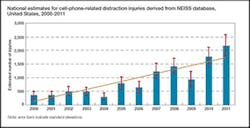As the joke goes, some people can’t chew gum and walk at the same time. Apparently, a large number of us can’t walk and text at the same time, either.
Fifty-two percent of distracted walking incidents involving cell phones happen at home – not adjacent to roadways, as many may believe, according to a study in the Journal of Safety Research. Sixty-eight percent of those injured are women, and 54 percent are people ages 40 or younger.
"Whether we are in the car or on foot, it is important to be aware of our surroundings, even if they are familiar," said Deborah A.P. Hersman, president and CEO of the National Safety Council. "More than half of all unintentional injuries each year happen at home, so don’t take your safety for granted. No call, text or update is worth an injury."
Distracted walking injuries involving cell phones accounted for an estimated 11,101 injuries between 2000 and 2011, making it a significant safety threat. The trend is so alarming that it was included for the first time in the annual National Safety Council statistical report, Injury Facts, which tracks the leading causes of unintentional injuries and deaths.
Unintentional injuries are the fourth leading cause of death in the U.S. and the primary focus of National Safety Month, observed each June.
While cell phone distracted walking injuries were most common among women and those ages 40 and younger, the study found the issue is impacting all age groups. Twenty-one percent of those injured were 71 and older. Talking on the phone accounted for 62 percent of injuries, the most common of which were dislocation or fracture, sprains or strains and concussions. Nearly 80 percent of the injuries were due to a fall.
The rise in cell phone distracted walking injuries parallels the eight-fold increase in cell phone use in the last 15 years. It is just as important to walk cell free as it is to drive cell-free. Pedestrians and drivers using cell phones are both impaired and too mentally distracted to fully focus on their surroundings, according to a white paper released by the National Safety Council, "Understanding the Distracted Brain," and research published in Accident Analysis and Prevention. For pedestrians, this distraction can cause them to trip, cross roads unsafely or walk into motionless objects such as street signs, doors or walls.
About the Author

Sandy Smith
Sandy Smith is the former content director of EHS Today, and is currently the EHSQ content & community lead at Intelex Technologies Inc. She has written about occupational safety and health and environmental issues since 1990.

